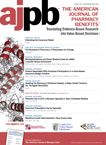Publication
Article
AJPB® Translating Evidence-Based Research Into Value-Based Decisions®
Extending the Consumer Model
Author(s):
It is now time for health plans and employers to create a consumer-focused benefit.
October 1, 2013, was an exciting day for me. No, it was not when I won the lotto or got down to my high school graduation weight. It was the day that we in the United States began on a route toward covering all US citizens for basic healthcare. It was also the next step in furthering the transition of individuals to healthcare consumers. Just as Medicare recipients are being asked to decide on whether they are going to enroll in Medicare Advantage or which Medicare Part D plan they will choose, we are now asking those that previously did not have healthcare coverage which plan they are going to choose. There are some that have concerns as to whether this relatively novice group of individuals will be able to make such a decision. I believe that people will learn and adjust. Will it take time? Yes. Will it take help, education, and support from others? Absolutely. What makes me so sure? Walk through any big-box store. People are making purchasing decisions all the time. What I do fi nd a bit quizzical is that we have seen the transition from individual to healthcare consumer by both the vulnerable and seniors. I believe it is time that we consciously begin to educate those who are covered by employers to become conscious consumers. Some employers have begun this journey and others have not. We have seen a few bold moves from organizations such as Walgreens that have moved their employees to private exchanges where they are being asked to take on greater responsibility for their health and healthcare decisions. I look forward to seeing both the quality and financial results associated with this move.
So where do others begin to help their employees or health plan members to become more consumer savvy if they are not ready to take the giant step that Walgreens did? If you look at the history of the pharmacy benefit, this is often used as the benefits “laboratory.” It is the area where many employers first tried value-based insurance design (VBID) prior to using VBID in the medical benefit. It is also the birthplace of price transparency. Caremark and other pharmacy benefi t managers (PBMs) began with their price transparency tools almost 10 years ago. (I only know this because my team was responsible for creating the tool.) Both of these design models support a consumer-focused model of health insurance. The 1 challenge that I continue to hear mentioned by those organizations that are utilizing these benefit tools is that consumers are not utilizing these tools to the degree the organizations would like them to. (I will focus on consumer engagement in a future column.) Although we still struggle with utilization of the tools that exist today, we need to continue to evolve into a more consumer-focused world.
So now it is time to take the next step. Health plans and employers, I challenge you to work with your consultants and your PBMs to create a consumer-focused benefit. Consider leveled plans (like the “metals” in the exchanges). Use consumer-focused decision support tools that your employees/members can use with their physicians. Align the consumer incentives to yours as the payer and the providers. By utilizing a crawl-walk-run methodology we can help people to become more actively involved in understanding and using their health benefits.
We all need information in order to make good decisions for ourselves. We also need to feel confi dent in our ability to understand and make decisions. Most of us feel a level of confi dence using the information available to us when we go to buy a car or a refrigerator. Let’s be honest, aren’t decisions about our health just as important as a car or refrigerator?







